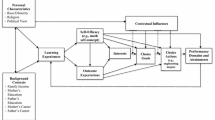Abstract
The early career paths of 436 men and 162 women who took up lectureships in British universities in English, modern languages, or psychology in 1971–1973 were identified. Proportionately fewer women (61 percent) than men (80 percent) held a full-time post in a British university ten years after their initial appointment. Among those retaining a university appointment, relatively fewer women (8 percent) than men (18 percent) had advanced to the level of senior lecturer, reader, or professor. Factors that may have served to restrict the career development of women in British universities are discussed. There now is a higher proportion of women than in the past in the pool of graduates who are qualified for academic posts. However, the end to university growth makes it unlikely that the sex ratio of academics will shift substantially in the 1980s or the 1990s. Since promotion has become more competitive than it was in the past, the current sex ratio at senior levels of appointment may also remain relatively unchanged.
Similar content being viewed by others
References
Astin, H. S. (1972). “Employment and career status of women psychologists,” American Psychologist 27: 371–381.
Bayer, A. E. and Astin, H. E. (1975). “Sex differentials in the academic reward system,” Science 188: 796–802.
Blackstone, T. and Fulton, O. (1974). “Men and women academics: an Anglo-American comparison of subject choices and research activity,” Higher Education 3: 119–140.
Blackstone, T. and Fulton, O. (1975). “Sex discrimination among university teachers: a British-American comparison,” British Journal of Sociology 26: 261–275.
Cole, J. R. (1979). Fair Science: Women in the Scientific Community, New York: Free Press.
Emmons, C. A. (1982). “A longitudinal study of the careers of a cohort of assistant professors in psychology,” American Psychologist 37: 1128–1138.
Endler, N. S., Rushton, J. P. and Roediger, H. L. (1978). “Productivity and scholarly impact (citations) of British, Canadian, and U.S. departments of psychology, 1975,” American Psychologist 33: 1064–1082.
Etaugh, C. (1980). “Effects of non-maternal care on children: research evidence and popular views,” American Psychologist 35: 309–319.
Garfield, E. (1979). Citation Indexing: Its Theory and Application in Science, Technology, and Humanities. New York: Wiley.
Myers, C. R. (1970). “Journal citations and scientific eminence in contemporary psychology,” American Psychologist 25: 1041–1048.
Over, R. (1981). “Women academics in Australian universities,” Australian Journal of Education 25: 166–176.
Over, R. (1982a). “Research productivity and impact of male and female psychologists,” American Psychologist 37: 24–31.
Over, R. (1982b). “The durability of scientific reputation,” Journal of the History of the Behavioral Sciences 18: 53–61.
Pyke, S. W. (1977). “Selected characteristics of the female psychologist in the labor force,” Canadian Psychological Review 18: 23–33.
Rendel, M. (1975). “Men and women in higher education,” Educational Review 27: 192–201.
Rendel, M. (1980). “How many women academics 1912–1976?,” Ch. 11 in R. Deem (Ed.), Schooling for Women's Work. London: Routledge and Kegan Paul.
Stapp, J. (1979). “Minorities and women: caught in an academic revolving door,” APA Monitor November: 14.
Szreter, R. (1983). “Opportunities for women as university teachers in England since the Robbins Report of 1963,” Studies in Higher Education 8: 139–150.
University Grants Committee (1983). Letter from the chairman to the vice-chancellors of British universities, dated 1 November 1983.
Williams, G., Blackstone, T. and Metcalf, D. (1974). The Academic Labour Market: Economic and Social Aspects of a Profession. Amsterdam: Elsevier.
Author information
Authors and Affiliations
Additional information
This study was supported by funding under the Australian Research Grants Scheme. Unless stated otherwise, the university statistics cited in this article were derived from the analyses published annually by the Department of Science and Education. I am grateful to Sandra Lancaster for her assistance in data analysis.
Rights and permissions
About this article
Cite this article
Over, R. Early career patterns of men and women in British universities. High Educ 14, 321–331 (1985). https://doi.org/10.1007/BF00136112
Issue Date:
DOI: https://doi.org/10.1007/BF00136112




